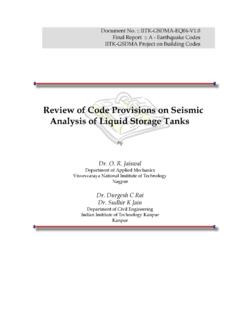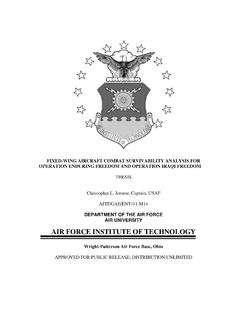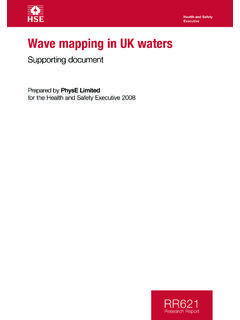Transcription of Analytical and Numerical Computation of Added …
1 UDC Josip BA I Jo ko PARUNOV Analytical and Numerical Computation of Added Mass in Ship Vibration analysis Authors address: University of Zagreb, Faculty of Mechanical Engineering and Naval Architecture, Ivana Lu i a 5, 10000 Zagreb, Croatia e-mail: (Primljeno):2012-10-02 Accepted (Prihva eno): 2012-12-28 Open for discussion (Otvoreno za raspravu): 2014-06-30 Original scientific paper Comparison between Analytical and Numerical determination of the Added hydrodynamic mass in ship vibration analysis is performed. Analytical analysis was done on a semi-submerged cylinder of a circular cross section. Numerical calculations were carried out by the boundary element method (BEM) implemented in NX Nastran finite element (FE) software. Fairly good agreement was found between the two methods for Added mass calculation.
2 Also, analysis of the real ship vibrations is performed. Free vertical vibrations of a 9200 TEU containership are analyzed where the hull was modelled by the beam finite elements (FE), while the shell plating was modelled by the plate FE without stiffness to define boundary elements of the wetted surface. Such calculated results are compared with the ones obtained by software DYANA which uses Timoshenko's beam FE and in which the Added mass is determined by traditional analytically-based method. Comparative analysis shows some moderate differences in the calculation of Added mass between the two approaches, indicating the need for further research on this topic. Keywords: Added mass, boundary element method, finite element method, ship vibrations Analiti ki i numeri ki prora un dodatne mase kod analize vibracije broda Izvorni znanstveni rad Obavljena je usporedba analiti kog i numeri kog odre ivanja dodatne mase okolne vode kod vibracija broda.
3 Teorijska analiza provedena je za poluuronjeni cilindar kru noga popre nog presjeka. Numeri ki prora un obavljen je metodom rubnih elemenata pomo u programa za primjenu kona nih elemenata NX Nastran. Dodatna hidrodinami ka masa odre ena dvjema metodama pokazuje dobro slaganje. Prikazana je tako er analiza vibracija realne brodske konstrukcije. Analizirane su vertikalne vibracije kontejnerskog broda 9200 TEU, pri emu je trup modeliran grednim kona nim elementima, a izvanjska oplata plo astim elementima bez krutosti kako bi se definirali rubni elementi oplakane povr ine. Tako dobiveni rezultati uspore eni su s onima dobivenim pomo u programa DYANA, koji koristi kona ne elemente Timo enkove grede i dodatnu masu odre enu tradicionalnom metodom zasnovanom na analiti kim rje enjima.
4 Usporedna analiza pokazala je odre ena odstupanja u izra unu dodatne hidrodinami ke mase dvjema metodama. Dalja istra ivanja potrebna su da bi se razjasnili razlozi ovih odstupanja. Klju ne rije i: dodatna masa, metoda kona nih elemenata, metoda rubnih elemenata, vibracije broda 11 Introduction Accurate evaluation of ship s vibration behaviour, natural frequencies and natural vibration modes, is important to avoid the resonance phenomenon that can be caused by periodic forces of propulsion engine, propeller and waves. Ship vibrations are greatly influenced by the inertial forces of surrounding fluid. These forces are proportional to the acceleration of wetted surface, and can consequently be represented by fictive fluid mass that vibrates along with the ship hull.
5 This fictive mass is called hydrodynamic Added mass , which in addition to the ship structure mass represents virtual mass . Added mass is usually significant, which in some cases reaches ship s displacement mass, and therefore must not be omitted in vibration analysis . Ship structure is numerically most often modelled with the finite element method (FEM). Added mass is either calculated separately and explicitly included into the analysis , or implicitly coupled using Numerical methods for solving problems of fluid-structure interaction. Traditionally, Added mass is in ship vibration analysis determined independently of the structural model according to some available Analytical solutions [1]. That procedure of Added mass Computation consists of two steps. Firstly, the Added mass of 2D cross-sections along the ship hull is determined, and secondly, the mass is corrected with the so called J factor, which takes into account 3D flow effects.
6 The J factor depends somewhat on the wetted surface shape, but mostly on the global vibration mode. The Added mass is then Added to the structural model to analyze wet vibrations of the ship hull. Such procedure for determining the Added mass is well known in shipbuilding industry, and proven to give good results for conventional ships that have pronounced strength deck and defined shapes of hull girder vibration. For ships such as passenger and RO-RO ships, the above mentioned method cannot be directly applied since the global vibration modes of the hull are not well defined and the J factor cannot be determined reliably. For unconventional ships, whose form is different from most common ship forms, the same problem arises. An example of such ships are dredgers, which amongst mentioned problems work in shallow waters for which the Added mass calculation using standard procedures is rather unreliable.
7 Vibration analysis for these ships represents tough challenge in the design phase, considering their powerful machinery with many vibration exciters [2]. An alternative to the described traditional method is the application of Numerical methods for solving problems of fluid-structure interaction such as the boundary element method (BEM) or Reynolds-averaged Navier Stokes (RANS) method [3]. Surrounding fluid can also be modelled with acoustic finite elements, but it takes huge amount of 3D finite elements to represent the fluid [4]. Therefore, it is more convenient to combine FEM for the ship structure with BEM for the fluid [5][6][7]. The advantages of such direct Numerical methods are that they are not constrained with conventional ship hull shapes and that methods implicitly include 3D effects.
8 There are different approaches of solving the Added mass with BEM, such as the projection approach [5], multi-pole method [6], panel method [8], etc. Numerical methods are advancing [3][9][10], and nowadays many commercial softwares provide solution to a wide spectrum of hydroelastic engineering problems including vibrations of fully or semi-immersed elastic bodies. However, Numerical methods are not without limitations and thus should be verified and validated before their practical usage. The purpose of the present study is to compare various computational methods of the Added mass of a vibrating ship, with the main aim to test practical applicability of the BEM. Although the theory is well known and implemented in many commercial FE codes, the studies demonstrating practical applicability of the BEM on hull girder vibration analysis are lacking in professional literature.
9 2 The paper begins with a short theoretical review of the Added mass concept and Analytical methods available for the Computation of Added mass. After that, a brief review of the BEM is provided. First, a comparative analysis is done on a simple example with the known Analytical solution. For that purpose, vertical transverse vibration analysis of a half-immersed circular cylinder was made. Analytically, the cylinder was analyzed via Timoshenko beam theory for wet vibrations in the deep water [11]. The cylinder and its surrounding fluid were also modelled with FEM and BEM respectively, and analyzed using NX Nastran solver. The results of the Numerical calculations were compared with the theoretical ones. In the second example, the free vibration analysis of the real ship was made.
10 Vertical vibrations of a 9200 TEU containership were analyzed where the hull was modelled by the beam finite elements, while the shell plating was modelled by the plate finite elements to define boundary elements of the wetted surface. Such calculated results are compared with the ones obtained by software DYANA which uses Timoshenko s beam finite elements and in which the Added mass is determined by traditional method [1][12]. Finally, corresponding conclusions about different methods for Added mass calculation are drawn. 2 Added mass Whenever acceleration is imposed on a fluid flow either by acceleration of a body or by acceleration externally imposed on the fluid, additional fluid forces will act on the surfaces in contact with the fluid. The simplest engineering description of the phenomenon of Added mass is that it determines the necessary work done to change the kinetic energy associated with the motion of the fluid [13].






